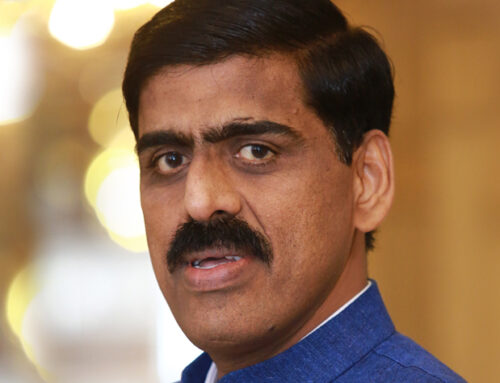Learn why Maaz Dixit is optimistic about the future of decarbonised buildings in India
Maaz is a passionate green building advocate who wants to be part of bringing about positive change in the building sector. She can read an entire Climatology coursebook in a single day, and spend whole days with affordable building residents to understand how their dwelling affects every aspect of their daily life.
The founder-partner of the energy consultancy firm Neev Energy and Sustainable Solutions, Maaz joined GBPN as a Project Consultant in October 2021. She has had considerable experience interacting with stakeholders – builders, architects, residents and government organisations. She has a deep understanding of the needs, challenges and aspirations of both ends of the building journey – the inhabitants, and the builders looking to incorporate energy-efficiency in their projects.
We caught up with Maaz to understand how she came into this sector, what her experiences were on the ground and what makes her so optimistic about the future of sustainable buildings in India.
What led to your deep engagement in the Green Buildings sector in India?
When I started working as an architect after my bachelor degree, I had a feeling that something was missing in the whole process. It was just all concrete and glass. There was no intuitive decision-making on the designs. That’s when I came across this program, Master of Technology in Building Energy Performance. Though I was in the first batch of the program, I’m happy I joined the program. It helped me understand why I felt there was something missing in the building designs. Climatology was a major subject in the program and I found it so interesting that I finished a whole course book in one day. I realised I was passionate about sustainable buildings, and that led to me entering this field.
Working with GBPN has helped me understand what it takes to implement a code or a policy – at a local level, state level and national level. It’s not just one building that I’m trying to make energy-efficient, but thousands of buildings that need that help right now. And when you are so deeply engaged in this sector, people are ready to listen to you when you tell them how a simple change in designs can make a substantial difference – to their building’s comfort and energy-efficiency and the occupants’ health.
You have held consultations ‘on the ground’ for GBPN projects, interacting with residents, particularly in the affordable sector. What is the sentiment on the ground regarding sustainable buildings?
The adult population, especially the elderly ones tend to be hesitant, it was not easy to convince them that their building was not designed sustainably. But when you speak to younger people, they are more aware and accepting of sustainable practices. I was pleasantly surprised when I interacted with a group of adolescent girls. They are quite an aware group; they knew, for example, that opening a door and a window on opposite walls, will facilitate cross-ventilation. They hear these things at school, talk about it, browse the net on smartphones to find information. These are the people who will be building, buying and living in houses in a few years. To some extent, they already realise the need and importance of healthy, sustainable buildings, and that fills me with hope for the future of sustainable buildings in India. In fact, a lot of people are eager for change – I even got questioned by an old lady why I wasn’t doing something to their building (laughs).
There is a general perception that green buildings are costly. Did you come across this during your stakeholder consultations? Is it true or just a perception?
People do have this perception. But it really depends on what stage you bring in the energy consultants. So, if the building is half-constructed, and then you try to get it changed to a green building, the cost is obviously going to be higher. But if you bring in a sustainable building consultant or energy consultant at the design stage itself, the cost will be marginal. So, that’s why a very early consultation of all the stakeholders is very essential to reduce the capital cost. For a recent MOU for a healthy affordable building pilot, we were able to influence the designs in the concept stage itself. Influencing the design process is a significant outcome for most of our projects.
The Energy Conservation Act was recently passed. How big do you think the impact will be on the building sector in India? What is GBPN’s strategy to seize this opportunity?
Before the Amendment Bill was passed, there was no effective implementation, since it was not a legislative document. Now that it’s a legislative document, there is more motivation for the states and local authorities to implement the ENS (Eco Niwas Samhita or the Energy Conservation Building Code for residential buildings). It’s definitely not going to happen overnight, but in a few years time we can expect better implementation of sustainable building practices.
The impact is certainly going to be substantial. So when you talk about this particular residential building code, there is a term in it, RETV – Residential Energy Transmittance Value – that itself is going to help buildings be much more comfortable. Each of the aspects in the code are leading to a positive impact on social, environmental and economic parameters.
With India aggressively pursuing renewable energy, and energy efficiency in all sectors, GBPN’s strategy in India was able to foresee the immense potential for policy implementation support in the building sector. We already have projects for ENS Guidelines and a tool for ENS Implementation. GBPN is already working with different government organisations in Gujarat. We are gearing up to work with more states in the coming year.
You went back to college to do your Masters after working for some time as an architect. What would you say to a student who may want to enter the Green Building sector after graduation?
You may not always find your inclination or passion during your college days, but whenever you do, enable yourself with education and experience. Don’t delay it, reinvent yourself in this field. The green building sector in India has immense scope for professionals looking to enter this field. This is not just in areas of policy advocacy, there is a lot of potential in areas like actual implementation on site, Environmental and Sustainable Governance (ESG) and many more specialisations. When you have the required certifications and knowledge, you will be able to convince the builders, owners and residents with quantitative analysis how they will benefit from sustainability and energy-efficiency practices. People will listen to you when they see logical explanations. A lot of buildings are still coming up in India, you can be a part of something that is a game-changer.
Share This Story, Choose Your Platform!
Stay in touch with how we’re transforming the buildings sector
GBPN runs innovative building policy reform programs in key regions around the world that aim to tackle the climate emergency by decarbonising the buildings sector. Stay up to date with our newsletter.
Stay in touch with how we’re transforming the buildings sector
GBPN runs innovative building policy reform programs in key regions around the world that aim to tackle the climate emergency by decarbonising the buildings sector. Stay up to date with our newsletter.







